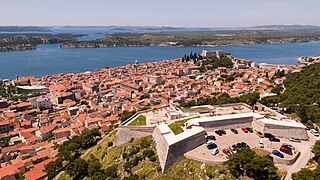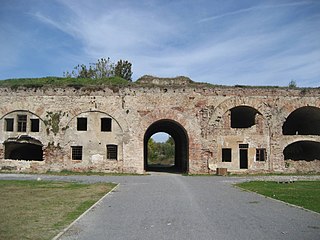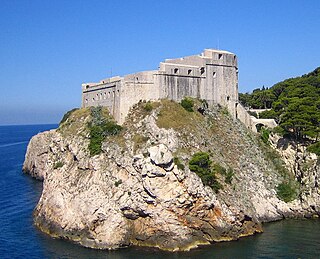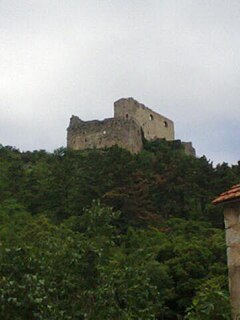 W
WThe Barone Fortress in Šibenik, Croatia, is an early modern fortress constructed in 1646 on Vidakuša hill above the city. Together with the remaining three city fortresses, it is a part of the Šibenik fortification system. It played a significant role in city's defense from the Ottomans during the Cretan War. For a long time, it carried the name of its main defender, Baron Christoph von Degenfeld. At the start of the 20th century, along with the surrounding neighborhood, it was renamed Šubićevac, after the medieval patrician family Šubić.
 W
WThe Fortress of Brod is a fortress in Slavonski Brod, Croatia with significant cultural heritage. The fortress was constructed in the 18th century by the Archduchy of Austria to create a defense against the Ottoman Empire.
 W
WGlavaš – Dinarić Fortress is a fortress located in the continental part of Dalmatia, Croatia. Dinarić is located below the Dinara mountain, northeast the town of Vrlika, near the village of Kijevo.
 W
WKnin Fortress is located near the tallest mountain in Croatia, Dinara, and near the source of the river Krka. It is the second largest fortress in Croatia and most significant defensive stronghold, and a historical town in the Šibenik-Knin County in the Dalmatian Hinterland. The construction of the fortress started as early as 9th century, while the current state was brought up in 17th and 18th centuries. It reached its peak during the reign of Demetrius Zvonimir, King of Croatia from 1076, as it served as a political center of the Croatian Kingdom under him.
 W
WFort Lovrijenac or St. Lawrence Fortress, often called "Dubrovnik's Gibraltar", is a fortress and theater outside the western wall of the city of Dubrovnik in Croatia, 37 metres (121 ft) above sea level. Famous for its plays and importance in resisting Venetian rule, it overshadows the two entrances to the city, from the sea and by land. Early in the 11th century the Venetians attempted to build a fort on the same spot where Fort Lovrijenac currently stands. If they had succeeded, they would have kept Dubrovnik under their power, but the people of the city beat them to it. The "Chronicles of Ragusa" reveal how the fort was built within just three months time and from then on constantly reconstructed. When the Venetian ships arrived, full of materials for the construction of the fort, they were told to return to Venice. The Croatian leg of the Red Bull Cliff Diving World Series takes place in Lovrijenac.
 W
WMirabella Fortress (Peovica) is a fortress located above town of Omiš in Split-Dalmatia County, in Dalmatia, Croatia.
 W
WMonkodonja is a hill fort occupied about 1800–1200 BC during the Bronze Age, located near the city of Rovinj in the Croatian region of Istria.
 W
WThe Nehaj Fortress [nexaj] is a fortress on the hill Nehaj in the town of Senj, Croatia.
 W
WNesactium was an ancient fortified town and hill fort of the Histri tribe. Its ruins are located in southern Istria, Croatia, between the villages of Muntić and Valtura.
 W
WPrevlaka is a small peninsula in southern Croatia, near the border with Montenegro, at the entrance to the Bay of Kotor on the eastern Adriatic coast.
 W
WProzor Fortress is a medieval fortress situated in the continental part of Split-Dalmatia County, in inland Dalmatia, just above the town of Vrlika in Croatia. From its origin as a small stronghold built by the ancient Illyrian tribe Dalmatae, it developed into a fortress in the 15th century, during the reign of Bosnian feudal lord Hrvoje Vukčić Hrvatinić.
 W
WThe Sisak Fortress is an early modern lowland fortification built on the bank of the Kupa River before its mouth into the Sava. It is situated in the suburb of modern-day city of Sisak, Sisak-Moslavina County, central Croatia.
 W
WSt. John's Fortress is an early modern fortress in Šibenik, Croatia, situated atop a hill north of the city's historical center. Named after a medieval church dedicated to St. John the Baptist that had stood there from at least 1444, the fortress, together with the adjacent Barone Fortress, was built during the Cretan War and successfully repelled consecutive Ottoman attacks in 1646 and 1647. A local name for the fortress, Tanaja, comes from one of its structures, a plier-shaped outwork, or tenaille.
 W
WSt. Michael's Fortress is a medieval fort in Šibenik, Šibenik-Knin County, Croatia, situated on a steep hill above the old historic center of the city. Its strategically favorable and dominant position made it the central part of Šibenik fortification system. The location was more or less continuously occupied since the Iron Age, as is witnessed by numerous archaeological findings from the era. The city of Šibenik was first mentioned on 25 December 1066 in a charter signed by King Peter Krešimir IV and verified by his courtiers. It is widely considered that the signing took place at St. Michael's Fortress.
 W
WStarigrad Fortress is a 15th-century fortress located near Omiš in Split-Dalmatia county, in Dalmatia, Croatia.
 W
WTvrđa (Citadel) is the old town of the city of Osijek in Croatia. It is the best-preserved and largest ensemble of Baroque buildings in Croatia and consists of a Habsburg star fort built on the right bank of the River Drava. Tvrđa has been described by the World Monuments Fund as "a unique example of an eighteenth-century baroque military, administrative, and commercial urban center".